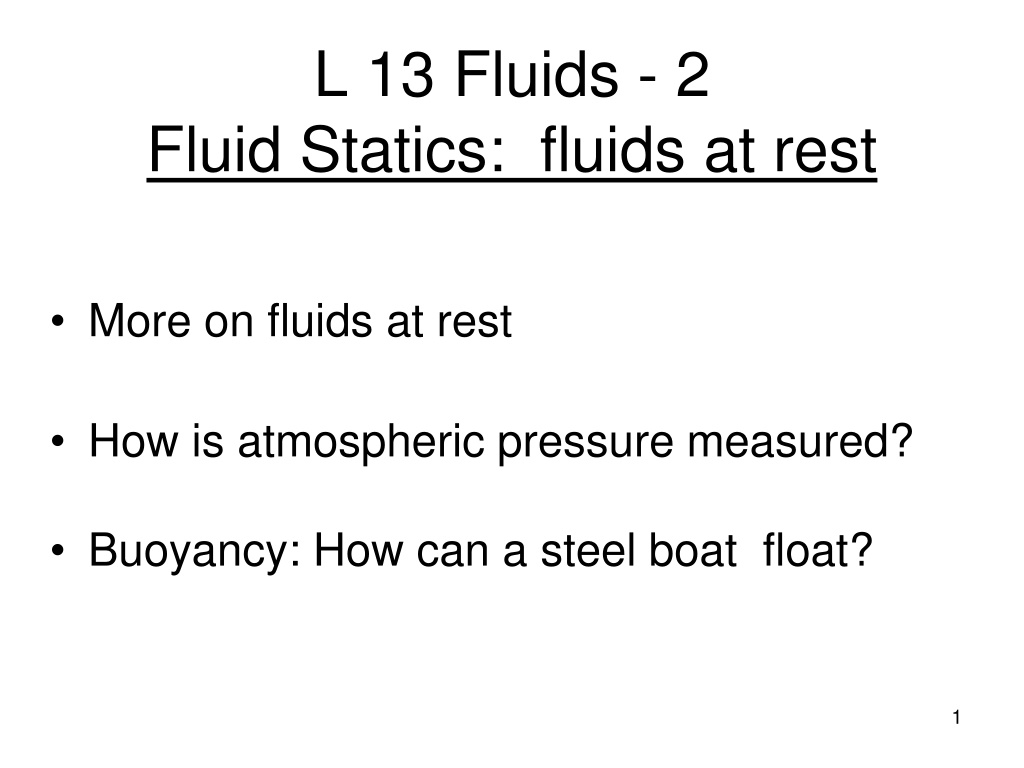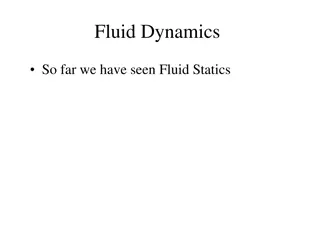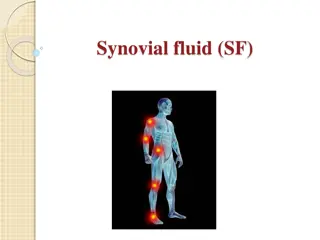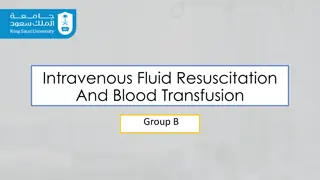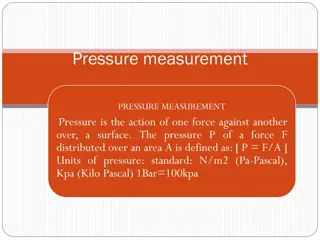Understanding Fluid Statics and Atmospheric Pressure Measurements
Exploring the concept of fluid statics, this content delves into topics such as how atmospheric pressure is measured, buoyancy, and why a steel boat can float. It covers the measurement of pressure, the relationship between pressure and depth in fluids, and demonstrations showcasing these principles. Additionally, it discusses the principles of Pascal's Vases and Barometers in measuring atmospheric pressure.
Uploaded on Sep 11, 2024 | 0 Views
Download Presentation

Please find below an Image/Link to download the presentation.
The content on the website is provided AS IS for your information and personal use only. It may not be sold, licensed, or shared on other websites without obtaining consent from the author. Download presentation by click this link. If you encounter any issues during the download, it is possible that the publisher has removed the file from their server.
E N D
Presentation Transcript
L 13 Fluids - 2 Fluid Statics: fluids at rest More on fluids at rest How is atmospheric pressure measured? Buoyancy: How can a steel boat float? 1
Review: Pressure = force per unit area Example: A large rectangular box of mass 4.8 kg has dimensions of 2 m x 3 m x 4 m. What pressure would the box exert on the floor depending on which side it is set on? 3 m P = F/A The force exerted by the box on the floor is equal to its weight w = m g = 4.8 kg x 10 m/s2 = 48 N. There are 3 possible values of the area A depending on which side rests on the floor: A1 = 2 m x 3 m = 6 m2 A2 = 2 m x 4 m = 8 m2 A3 = 3 m x 4 m = 12 m2. 2 m 4 m w = mg P1 = w/A1 = 48 N / 6 m2 = 8 N/m2 = 8 Pa P2 = w/A2 = 48 N / 8 m2 = 6 N/m2 = 6 Pa P3 = w/A3 = 48 N / 12 m2 = 4 N/m2 = 4 Pa 2
Pressure in a fluid increases with depth h The pressure at the surface is atmospheric pressure (1 atm) = 1.013 105 N/m2 = 1.013 105 Pa 105 Pa Po = Patm Pressure at depth h h P(h) = Po + g h P(h) = density (kg/m3) 1000 kg/m3 for water g h 1000 x 10 x h = 104 h Density = Mass/Vol. = 3
DEMONSTRATION Since the pressure increases with depth, the speed of the water leaking from the bottom hole is larger than that from the higher ones. P1 P2 > P1 P3 > P2 4
Pressure depends only on depth P = Po = 1 atm 105 Pa 10 m P = Po + Po= 2 atm 2 x105 Pa 20 m 10 m P = Po + 2Po= 3 atm 3 x105 Pa All 3 objects experience same pressure 5
Pressure is always perpendicular to the surface of an object Pressure has the same value in all directions 6
Pascals Vases The fluid levels are the same in all each tube irrespective of their shape 7
Barometer measures atmospheric pressure Inverted closed tube filled with liquid The column of liquid is held up by the pressure of the liquid in the tank. Pliquid PATM at surface, PATM PATM the atmosphere holds the liquid up. Pliquid 8
Barometric pressure Atmospheric pressure can support a column of water 10.3 m high, or a column of mercury (which is 13.6 times as dense as water) 30 inches high the mercury barometer Today s Weather 9
Pascals Principle If you apply pressure to an enclosed fluid, that pressure is transmitted equally to all parts of the fluid If I exert extra pressure on the fluid with a piston, the pressure in the fluid increases everywhere by that amount Cartesian diver W 10
Pascals Principle A change in pressure in an enclosed Fluid at rest is transmitted undiminished to all points in the fluid 5 kg W = 50 N W = 10 N 1kg area 5 m2 area 1 m2 h h 11
A hydraulic car lift Pressure is F / A At the same depth the pressures are the same so F1 /A1 = F2 /A2, or = A A F F 2 2 1 1 with a little force you can lift a heavy object! the jack 12
Water pumps and drinking straws A ground level pump can only be used to cause water to rise to a certain maximum height since it uses atmospheric pressure to lift the water for deeper wells the pump must be located at the bottom When you use a straw, you create a vacuum in your mouth and atmospheric pressure pushes the liquid up 13
Pressure depends only on depth Dam The pressure at the bottom of the lake is higher than at the top The dam must be thicker at its base The pressure does not depend on how far back the lake extends 14
Blood Pressure Sphygmomanometer The blood pressure in your feet can be greater than the blood pressure in your head depending on whether a person is standing or reclining 15
Buoyancy why things float The trick is to keep the water on the outside, and avoid hitting icebergs (which also float), which are not easily seen, since 90% of it is submerged The hole in the Titanic hull was only about 1 m2 16
Buoyant Force submerged object that has a mass density O PTopA F = P A The density of the water is h W PBottomA 17
Buoyant force The water pushes down on the top of the object, and pushes up on the bottom of the object The difference between the upward force and the downward force is the buoyant force FB since the pressure is larger on the bottom the buoyant force is UP There is a buoyant force even if the object does not float 18
Archimedes principle The buoyant force on an object in a fluid equals the weight of the fluid which it displaces. Anything less dense than water will float in water water weighs 10 N/liter each liter of displaced water provides 10 N of buoyant force this works for objects in water helium balloons (density of He = 0.18 kg/m3) hot air balloons the density of hot air is lower than the density of cool air so the weight of the cool air that is displaced is larger than the weight of the balloon 19
Will it float? The object will float if the buoyant force is enough to support the object s weight The object will displace just enough water so that the buoyant force = its weight If it displaces as much water as possible and this does not match its weight, it will sink. Objects that have a density less than water will always float in water, e.g., oil A steel bolt will float in mercury ( = 13.6 g/cm3) 20
Floating objects heavier object lighter object 21
Oil Tankers empty tanker full tanker 22
example problem An object having a volume of 6 liters and weighing W = 30 N is placed in a tank of water. What will happen? Will it sink? Will it float? What fraction of its volume will be submerged if it floats? If the object were completely submerged, the buoyant force would be FB, max = 10N/liter x 6 liters = 60 N thus, the object will float with half of its volume submerged, so that FB = W = 30 N W FB 23
Floating in a cup of water Only a thin layer of water around the hull is needed for the ship to float! 24
